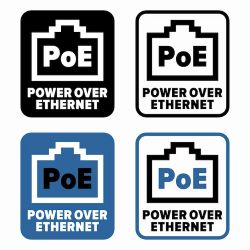
Jun 2023
0 Comments
MackTech Biz
Exploring Power over Ethernet (PoE) Switches: Revolutionizing Network Connectivity and Power Management
Introduction:
Power over Ethernet (PoE) switches have emerged as a transformative technology in the field of network connectivity, providing a seamless integration of power and data transmission over Ethernet cables. This comprehensive article aims to delve into the technical intricacies of PoE switches, their underlying principles, benefits, implementation considerations, and the future of this technology.
1. Understanding Power over Ethernet (PoE):
1.1. PoE Basics: Definition, Standards, and Evolution
Power over Ethernet (PoE) is a technology that enables the simultaneous transmission of power and data over standard Ethernet cables. It eliminates the need for separate power cables, simplifying installation and reducing costs. The article explores the evolution of PoE standards, including IEEE 802.3af, 802.3at, and the latest 802.3bt, each offering different power levels and capabilities.
1.2. Power Sourcing Equipment (PSE) and Powered Devices (PDs)
To facilitate PoE, two main components are involved: Power Sourcing Equipment (PSE) and Powered Devices (PDs). PSE refers to the PoE switch or injector that supplies power, while PDs are the devices such as IP phones, wireless access points, and surveillance cameras that receive power and data from the PSE.
1.3. IEEE 802.3af, 802.3at, and 802.3bt: Examining PoE Standards and Their Capabilities
This section provides a detailed breakdown of the different PoE standards and their capabilities. IEEE 802.3af (PoE) provides up to 15.4 watts of power per port, 802.3at (PoE+) offers up to 30 watts, and the latest 802.3bt (PoE++) delivers up to 90 watts, enabling power-hungry devices such as pan-tilt-zoom cameras and high-performance access points.
2. How PoE Switches Work:
2.1. Key Components and Architecture of a PoE Switch
This section explores the inner workings of a PoE switch, including its key components such as power supply units, Ethernet interfaces, and power management circuits. The architecture of a PoE switch is explained, highlighting how it integrates power sourcing capabilities and data switching functionalities.
2.2. Power Management and Allocation Techniques in PoE Switches
Efficient power management is crucial for PoE switches. The article discusses various techniques employed, such as power budgeting, prioritization, and intelligent power allocation algorithms. These techniques ensure optimal power delivery to PDs while maintaining network stability and preventing overloading.
2.3. Power Budgeting and Classification Mechanisms for Efficient Power Delivery
PoE switches allocate power based on the classification mechanisms defined by the IEEE standards. The article covers the power budgeting process, which involves calculating the total power available and distributing it among connected PDs according to their power requirements and classification.
3. Advantages and Benefits of PoE Switches:
3.1. Simplified Installation and Reduced Wiring Complexity
3.2. Flexibility in Device Placement and Mobility
With PoE switches, devices can be deployed in locations without nearby power sources. This flexibility allows for greater freedom in device placement, enabling the deployment of devices in areas that were previously challenging or costly to reach. The article discusses the advantages of mobility in scenarios such as office environments and IoT applications.
3.3. Cost Savings and Energy Efficiency
PoE switches offer cost-saving benefits by reducing the overall infrastructure costs associated with power cabling. The article explains how PoE eliminates the need for dedicated electrical circuits, reducing installation expenses. Additionally, the intelligent power management features of PoE switches promote energy efficiency by dynamically adjusting power consumption based on device requirements.
3.4. Enhanced Network Reliability and Scalability
PoE switches contribute to improved network reliability by centralizing power management. They offer features such as power monitoring, device status detection, and automatic power recovery, which enhance network availability. Furthermore, PoE facilitates network scalability by simplifying the addition and relocation of devices without requiring extensive rewiring.
4. Implementation Considerations:
4.1. Power Budget Planning: Calculating Power Requirements for PoE Devices
To ensure successful PoE implementations, careful power budget planning is essential. This section discusses the process of calculating power requirements for PoE devices, considering factors such as power class, cable length, and potential power losses. It provides practical guidelines for determining power budgets based on the specific needs of the network.
4.2. Network Infrastructure Design Considerations
Effective network infrastructure design is crucial for PoE deployments. This article explores considerations such as cable quality, length limitations, and the impact of power dissipation on network performance. Additionally, it discusses the importance of proper grounding and surge protection to safeguard PoE equipment and connected devices.
4.3. PoE Switch Features and Selection Criteria
Choosing the right PoE switch is critical for achieving optimal performance. This section outlines important features to consider when selecting PoE switches, including power budget, port density, PoE standards support, management capabilities, and network security features. It offers insights to help network administrators make informed decisions.
4.4. Integration with Other Network Components: Routers, Access Points, IP Cameras, etc.
PoE switches seamlessly integrate with various network components. The article explores the integration of PoE switches with routers, wireless access points, IP cameras, and other devices. It emphasizes the importance of compatibility and interoperability for successful integration and the expansion of PoE-powered networks.
5. PoE Switches in Various Industries:
5.2. Internet of Things (IoT) and Smart Building Applications
IoT devices rely on PoE switches for power and connectivity. The article explores the role of PoE in IoT deployments, enabling smart building applications such as environmental monitoring, asset tracking, and smart lighting. It emphasizes the scalability and cost advantages of PoE for large-scale IoT implementations.
5.3. Surveillance and Security Systems
PoE switches play a vital role in surveillance and security systems. This section delves into the integration of PoE switches with IP cameras, access control systems, and video management software. It highlights the benefits of centralized power management, reliable data transmission, and simplified installation in security deployments.
5.4. Healthcare, Education, and Hospitality Sectors
The healthcare, education, and hospitality sectors can greatly benefit from PoE switches. The article explores the applications of PoE in these industries, including wireless access points, nurse call systems, IP telephony, and digital signage. It emphasizes the importance of reliable and efficient power delivery in critical environments.
6. Emerging Trends and Future Developments:
6.2. PoE beyond Ethernet: Wireless Power Transmission
Wireless power transmission is an area of ongoing research and development. This section explores the concept of PoE extending beyond Ethernet cables and leveraging technologies like resonant inductive coupling for wireless power transfer. It discusses the potential applications and challenges associated with wireless PoE.
6.3. Integration with Power Management and Control Systems
Integrating PoE switches with power management and control systems can enhance energy efficiency and provide advanced monitoring capabilities. This section explores the integration of PoE switches with building management systems and power monitoring software, enabling centralized control and intelligent energy optimization.
6.4. PoE Standards Roadmap: An Outlook on Evolving Specifications
The article concludes by providing an outlook on the future of PoE standards, including potential advancements in power delivery, efficiency improvements, and standardization efforts. It emphasizes the need for continued innovation to meet the evolving demands of power-hungry devices and emerging technologies.
6.5 Progression of IEEE standards for PoE (Power over Ethernet)
| Standard | IEEE 802.3af | IEEE 802.3at | IEEE 802.3bt | |||
| Power | 15.4 Watt | 30 Watt | 45 Watt | 60 Watt | 75 Watt | 90 Watt |
| Year | 2003 | 2009 | 2018 High power standard | |||
Conclusion:
Power over Ethernet (PoE) switches have revolutionized network connectivity by combining power and data transmission, enabling efficient and convenient deployment of various devices. This article provided an in-depth exploration of PoE switch technology, from its fundamental principles to its implementation considerations and future trends. As PoE continues to evolve, its adoption across industries is expected to grow, fostering the development of smarter and more connected environments.

